Leadership Traits Analysis: Evaluation and Comparison (MGT 522)
VerifiedAdded on 2022/08/23
|9
|1669
|18
Report
AI Summary
This report analyzes leadership traits, focusing on dominance, cooperation, situational, transformational, and transactional leadership approaches. The assignment begins with an introduction to leadership traits, emphasizing qualities like accountability, resilience, and empathy. A literature review summarizes Nichols' (2016) research on the impact of leadership experience on desired traits, highlighting the importance of cooperation and the reduced desire for dominance with increased leadership experience, particularly among women. The discussion and evaluation section delves into the research, exploring how leadership experience can influence attitudes and behaviors. The report also touches upon situational, transformational, and transactional leadership styles, citing Lynch (2015). The conclusion summarizes the key findings, emphasizing the importance of understanding leadership traits for effective leadership and decision-making. The report adheres to the provided assignment structure including introduction, literature review, discussion and evaluation, conclusion, and APA references.
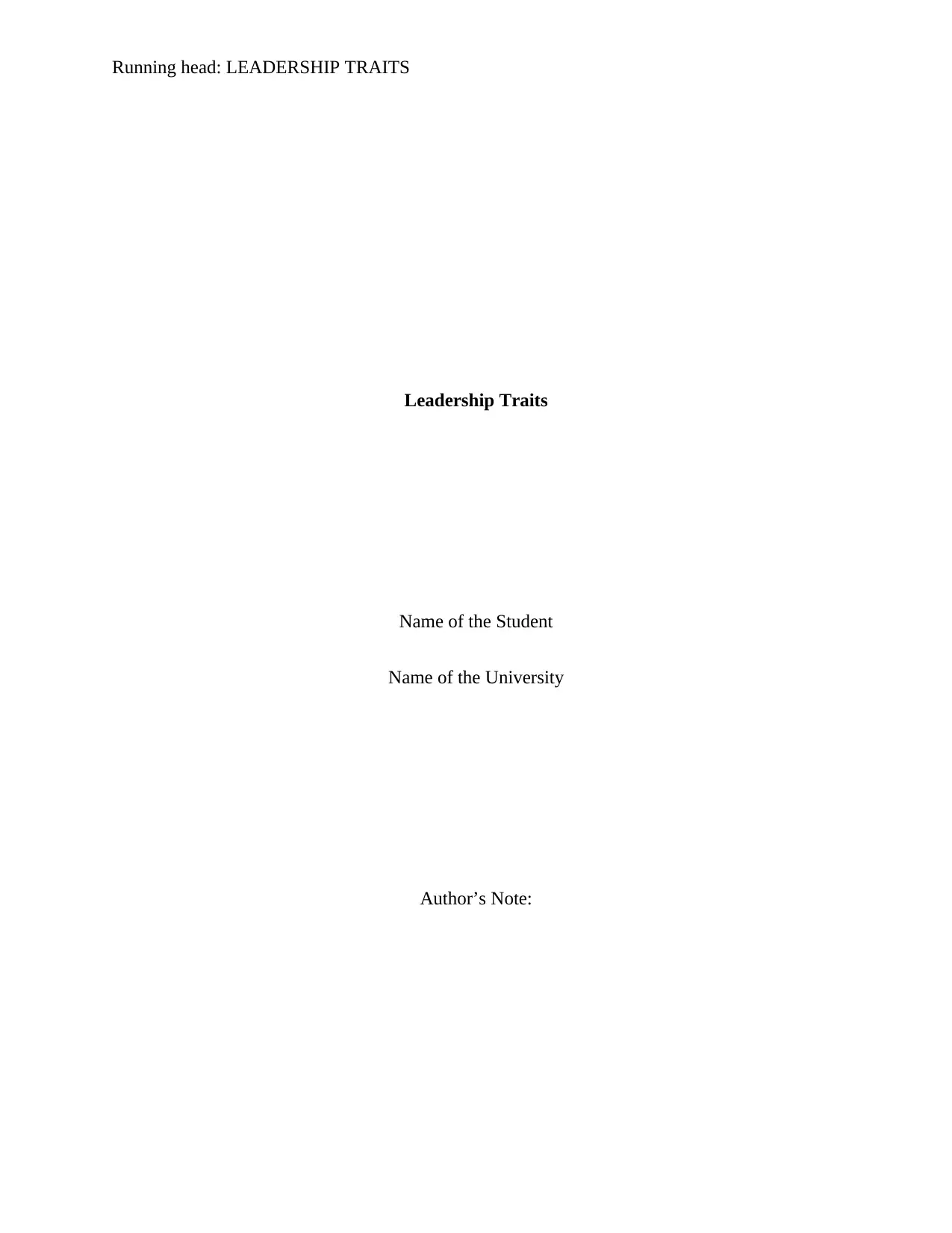
Running head: LEADERSHIP TRAITS
Leadership Traits
Name of the Student
Name of the University
Author’s Note:
Leadership Traits
Name of the Student
Name of the University
Author’s Note:
Paraphrase This Document
Need a fresh take? Get an instant paraphrase of this document with our AI Paraphraser
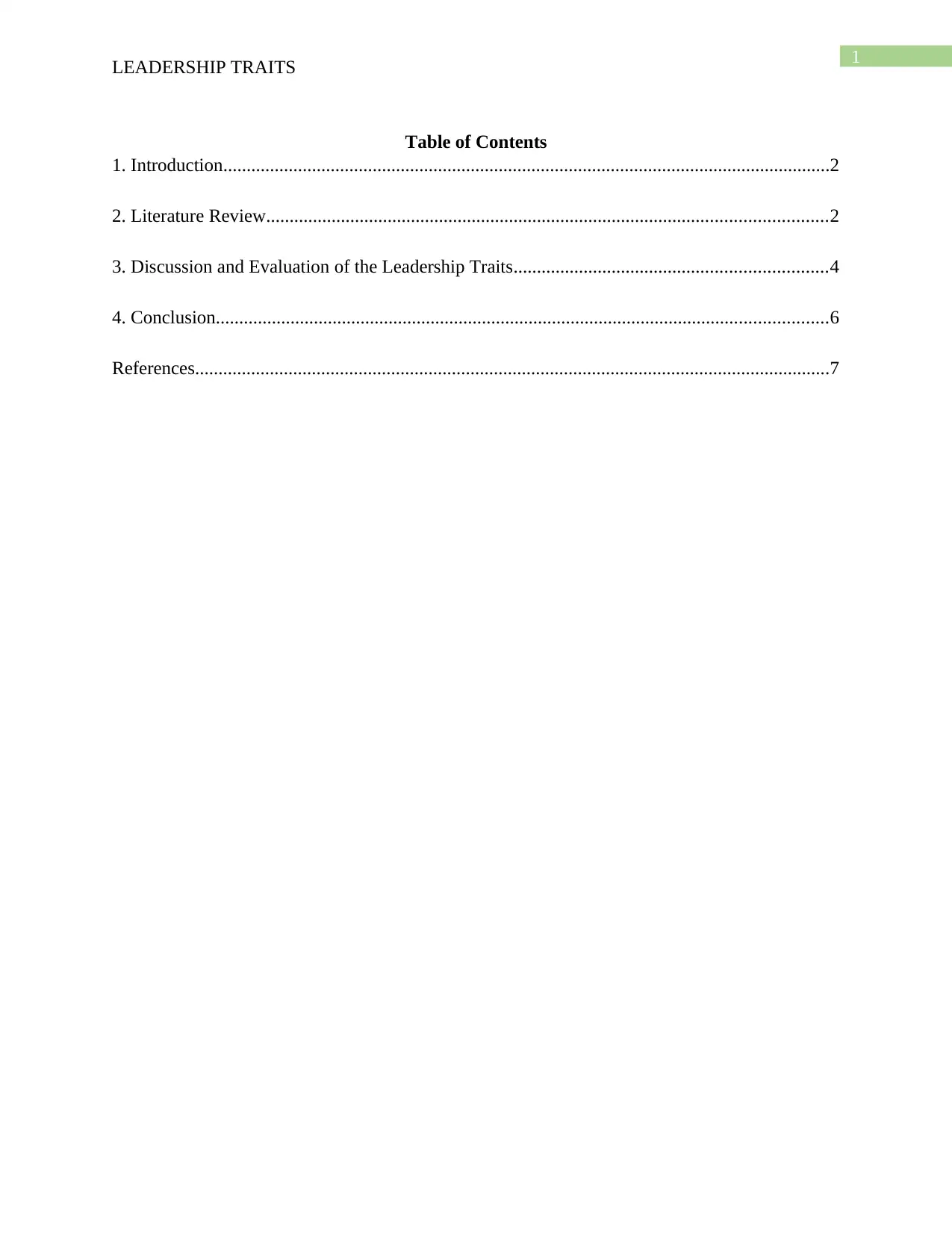
1
LEADERSHIP TRAITS
Table of Contents
1. Introduction..................................................................................................................................2
2. Literature Review........................................................................................................................2
3. Discussion and Evaluation of the Leadership Traits...................................................................4
4. Conclusion...................................................................................................................................6
References........................................................................................................................................7
LEADERSHIP TRAITS
Table of Contents
1. Introduction..................................................................................................................................2
2. Literature Review........................................................................................................................2
3. Discussion and Evaluation of the Leadership Traits...................................................................4
4. Conclusion...................................................................................................................................6
References........................................................................................................................................7
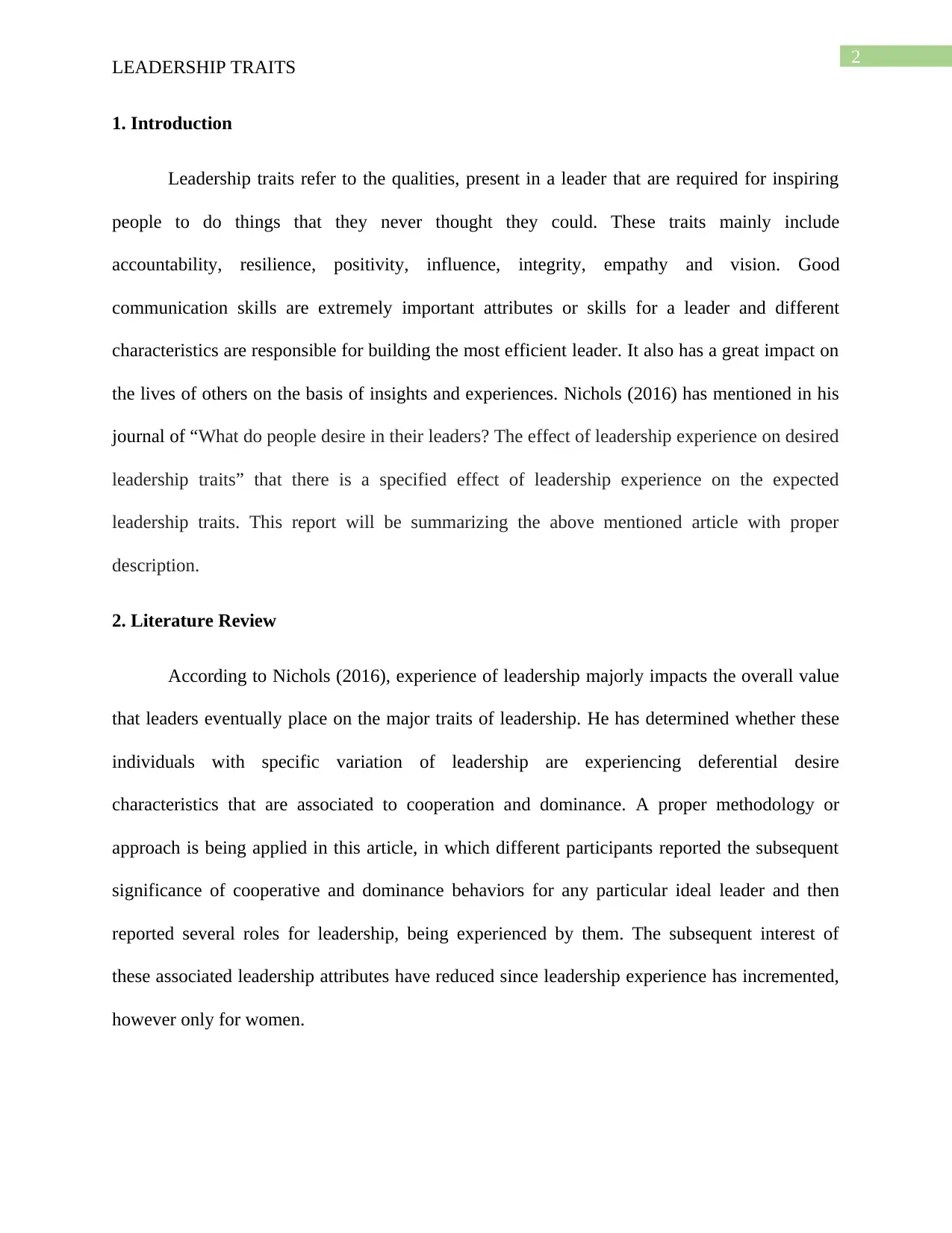
2
LEADERSHIP TRAITS
1. Introduction
Leadership traits refer to the qualities, present in a leader that are required for inspiring
people to do things that they never thought they could. These traits mainly include
accountability, resilience, positivity, influence, integrity, empathy and vision. Good
communication skills are extremely important attributes or skills for a leader and different
characteristics are responsible for building the most efficient leader. It also has a great impact on
the lives of others on the basis of insights and experiences. Nichols (2016) has mentioned in his
journal of “What do people desire in their leaders? The effect of leadership experience on desired
leadership traits” that there is a specified effect of leadership experience on the expected
leadership traits. This report will be summarizing the above mentioned article with proper
description.
2. Literature Review
According to Nichols (2016), experience of leadership majorly impacts the overall value
that leaders eventually place on the major traits of leadership. He has determined whether these
individuals with specific variation of leadership are experiencing deferential desire
characteristics that are associated to cooperation and dominance. A proper methodology or
approach is being applied in this article, in which different participants reported the subsequent
significance of cooperative and dominance behaviors for any particular ideal leader and then
reported several roles for leadership, being experienced by them. The subsequent interest of
these associated leadership attributes have reduced since leadership experience has incremented,
however only for women.
LEADERSHIP TRAITS
1. Introduction
Leadership traits refer to the qualities, present in a leader that are required for inspiring
people to do things that they never thought they could. These traits mainly include
accountability, resilience, positivity, influence, integrity, empathy and vision. Good
communication skills are extremely important attributes or skills for a leader and different
characteristics are responsible for building the most efficient leader. It also has a great impact on
the lives of others on the basis of insights and experiences. Nichols (2016) has mentioned in his
journal of “What do people desire in their leaders? The effect of leadership experience on desired
leadership traits” that there is a specified effect of leadership experience on the expected
leadership traits. This report will be summarizing the above mentioned article with proper
description.
2. Literature Review
According to Nichols (2016), experience of leadership majorly impacts the overall value
that leaders eventually place on the major traits of leadership. He has determined whether these
individuals with specific variation of leadership are experiencing deferential desire
characteristics that are associated to cooperation and dominance. A proper methodology or
approach is being applied in this article, in which different participants reported the subsequent
significance of cooperative and dominance behaviors for any particular ideal leader and then
reported several roles for leadership, being experienced by them. The subsequent interest of
these associated leadership attributes have reduced since leadership experience has incremented,
however only for women.
⊘ This is a preview!⊘
Do you want full access?
Subscribe today to unlock all pages.

Trusted by 1+ million students worldwide
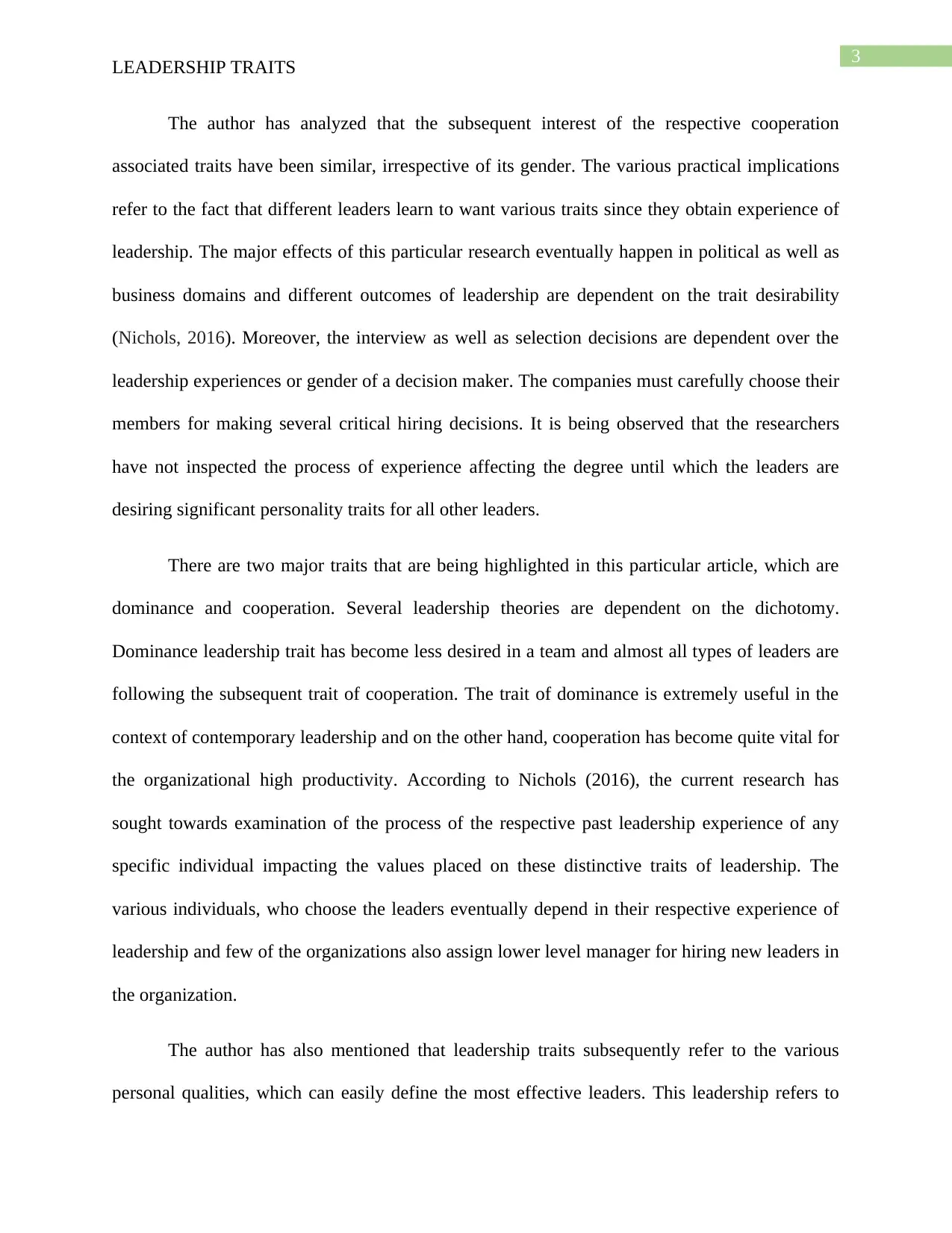
3
LEADERSHIP TRAITS
The author has analyzed that the subsequent interest of the respective cooperation
associated traits have been similar, irrespective of its gender. The various practical implications
refer to the fact that different leaders learn to want various traits since they obtain experience of
leadership. The major effects of this particular research eventually happen in political as well as
business domains and different outcomes of leadership are dependent on the trait desirability
(Nichols, 2016). Moreover, the interview as well as selection decisions are dependent over the
leadership experiences or gender of a decision maker. The companies must carefully choose their
members for making several critical hiring decisions. It is being observed that the researchers
have not inspected the process of experience affecting the degree until which the leaders are
desiring significant personality traits for all other leaders.
There are two major traits that are being highlighted in this particular article, which are
dominance and cooperation. Several leadership theories are dependent on the dichotomy.
Dominance leadership trait has become less desired in a team and almost all types of leaders are
following the subsequent trait of cooperation. The trait of dominance is extremely useful in the
context of contemporary leadership and on the other hand, cooperation has become quite vital for
the organizational high productivity. According to Nichols (2016), the current research has
sought towards examination of the process of the respective past leadership experience of any
specific individual impacting the values placed on these distinctive traits of leadership. The
various individuals, who choose the leaders eventually depend in their respective experience of
leadership and few of the organizations also assign lower level manager for hiring new leaders in
the organization.
The author has also mentioned that leadership traits subsequently refer to the various
personal qualities, which can easily define the most effective leaders. This leadership refers to
LEADERSHIP TRAITS
The author has analyzed that the subsequent interest of the respective cooperation
associated traits have been similar, irrespective of its gender. The various practical implications
refer to the fact that different leaders learn to want various traits since they obtain experience of
leadership. The major effects of this particular research eventually happen in political as well as
business domains and different outcomes of leadership are dependent on the trait desirability
(Nichols, 2016). Moreover, the interview as well as selection decisions are dependent over the
leadership experiences or gender of a decision maker. The companies must carefully choose their
members for making several critical hiring decisions. It is being observed that the researchers
have not inspected the process of experience affecting the degree until which the leaders are
desiring significant personality traits for all other leaders.
There are two major traits that are being highlighted in this particular article, which are
dominance and cooperation. Several leadership theories are dependent on the dichotomy.
Dominance leadership trait has become less desired in a team and almost all types of leaders are
following the subsequent trait of cooperation. The trait of dominance is extremely useful in the
context of contemporary leadership and on the other hand, cooperation has become quite vital for
the organizational high productivity. According to Nichols (2016), the current research has
sought towards examination of the process of the respective past leadership experience of any
specific individual impacting the values placed on these distinctive traits of leadership. The
various individuals, who choose the leaders eventually depend in their respective experience of
leadership and few of the organizations also assign lower level manager for hiring new leaders in
the organization.
The author has also mentioned that leadership traits subsequently refer to the various
personal qualities, which can easily define the most effective leaders. This leadership refers to
Paraphrase This Document
Need a fresh take? Get an instant paraphrase of this document with our AI Paraphraser
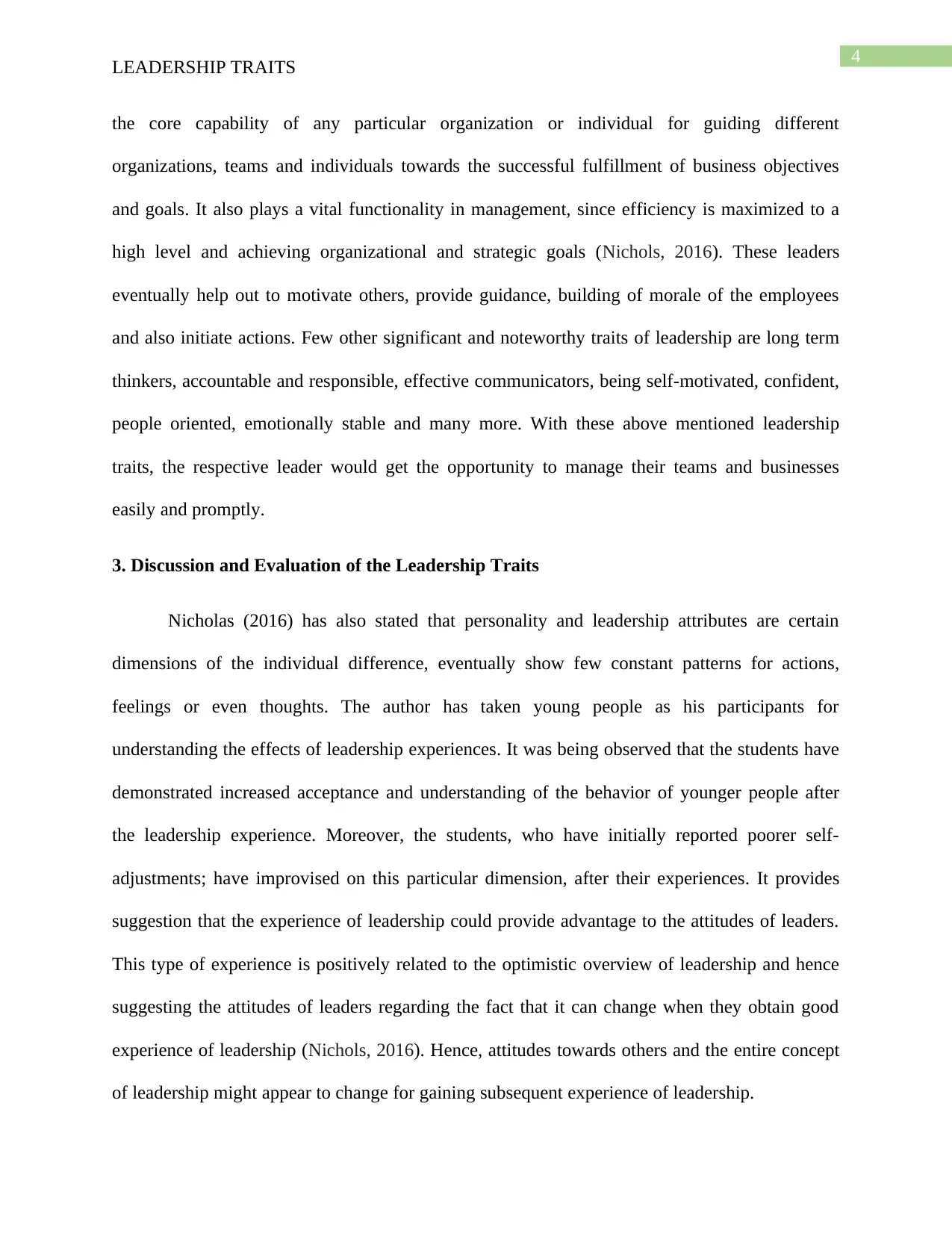
4
LEADERSHIP TRAITS
the core capability of any particular organization or individual for guiding different
organizations, teams and individuals towards the successful fulfillment of business objectives
and goals. It also plays a vital functionality in management, since efficiency is maximized to a
high level and achieving organizational and strategic goals (Nichols, 2016). These leaders
eventually help out to motivate others, provide guidance, building of morale of the employees
and also initiate actions. Few other significant and noteworthy traits of leadership are long term
thinkers, accountable and responsible, effective communicators, being self-motivated, confident,
people oriented, emotionally stable and many more. With these above mentioned leadership
traits, the respective leader would get the opportunity to manage their teams and businesses
easily and promptly.
3. Discussion and Evaluation of the Leadership Traits
Nicholas (2016) has also stated that personality and leadership attributes are certain
dimensions of the individual difference, eventually show few constant patterns for actions,
feelings or even thoughts. The author has taken young people as his participants for
understanding the effects of leadership experiences. It was being observed that the students have
demonstrated increased acceptance and understanding of the behavior of younger people after
the leadership experience. Moreover, the students, who have initially reported poorer self-
adjustments; have improvised on this particular dimension, after their experiences. It provides
suggestion that the experience of leadership could provide advantage to the attitudes of leaders.
This type of experience is positively related to the optimistic overview of leadership and hence
suggesting the attitudes of leaders regarding the fact that it can change when they obtain good
experience of leadership (Nichols, 2016). Hence, attitudes towards others and the entire concept
of leadership might appear to change for gaining subsequent experience of leadership.
LEADERSHIP TRAITS
the core capability of any particular organization or individual for guiding different
organizations, teams and individuals towards the successful fulfillment of business objectives
and goals. It also plays a vital functionality in management, since efficiency is maximized to a
high level and achieving organizational and strategic goals (Nichols, 2016). These leaders
eventually help out to motivate others, provide guidance, building of morale of the employees
and also initiate actions. Few other significant and noteworthy traits of leadership are long term
thinkers, accountable and responsible, effective communicators, being self-motivated, confident,
people oriented, emotionally stable and many more. With these above mentioned leadership
traits, the respective leader would get the opportunity to manage their teams and businesses
easily and promptly.
3. Discussion and Evaluation of the Leadership Traits
Nicholas (2016) has also stated that personality and leadership attributes are certain
dimensions of the individual difference, eventually show few constant patterns for actions,
feelings or even thoughts. The author has taken young people as his participants for
understanding the effects of leadership experiences. It was being observed that the students have
demonstrated increased acceptance and understanding of the behavior of younger people after
the leadership experience. Moreover, the students, who have initially reported poorer self-
adjustments; have improvised on this particular dimension, after their experiences. It provides
suggestion that the experience of leadership could provide advantage to the attitudes of leaders.
This type of experience is positively related to the optimistic overview of leadership and hence
suggesting the attitudes of leaders regarding the fact that it can change when they obtain good
experience of leadership (Nichols, 2016). Hence, attitudes towards others and the entire concept
of leadership might appear to change for gaining subsequent experience of leadership.
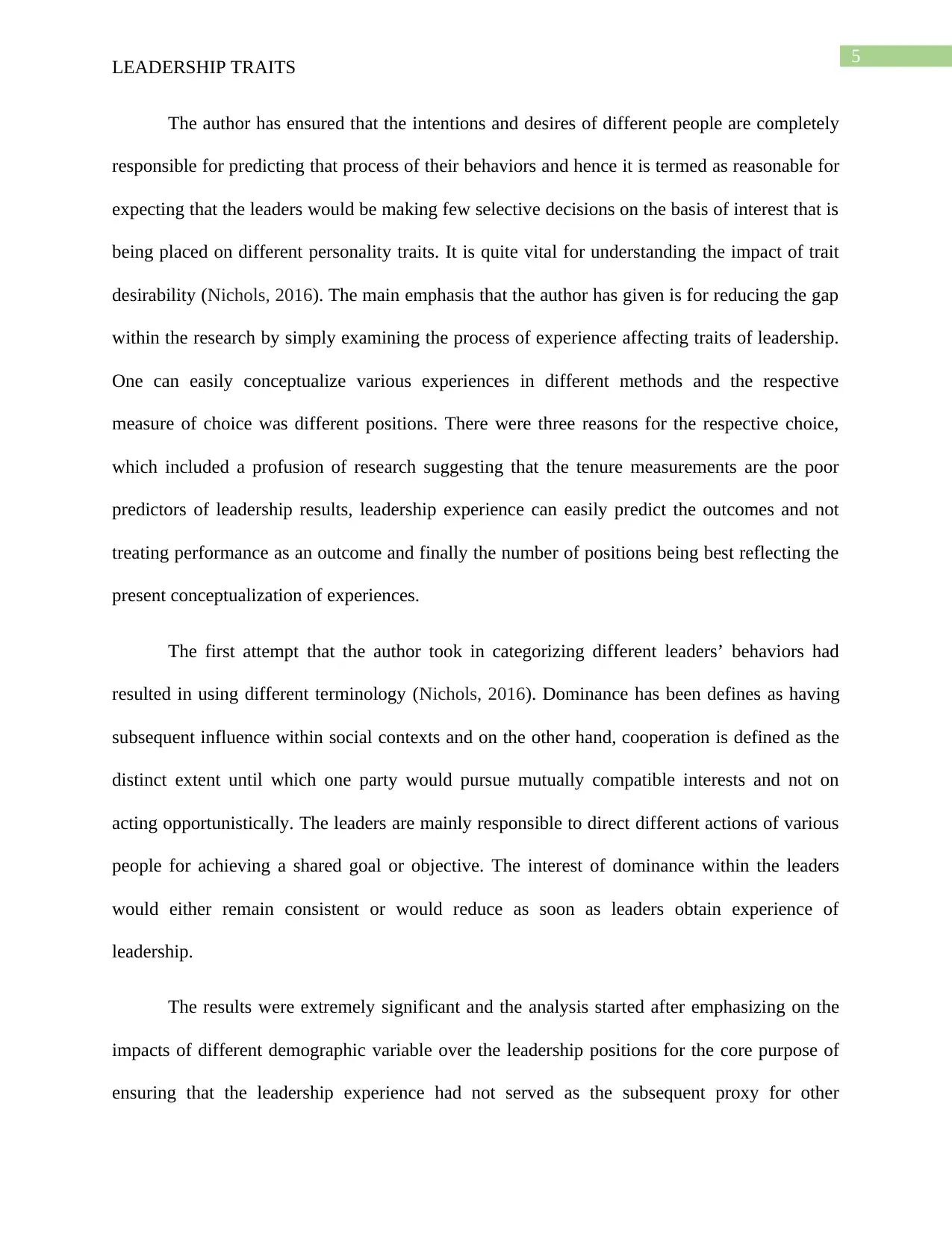
5
LEADERSHIP TRAITS
The author has ensured that the intentions and desires of different people are completely
responsible for predicting that process of their behaviors and hence it is termed as reasonable for
expecting that the leaders would be making few selective decisions on the basis of interest that is
being placed on different personality traits. It is quite vital for understanding the impact of trait
desirability (Nichols, 2016). The main emphasis that the author has given is for reducing the gap
within the research by simply examining the process of experience affecting traits of leadership.
One can easily conceptualize various experiences in different methods and the respective
measure of choice was different positions. There were three reasons for the respective choice,
which included a profusion of research suggesting that the tenure measurements are the poor
predictors of leadership results, leadership experience can easily predict the outcomes and not
treating performance as an outcome and finally the number of positions being best reflecting the
present conceptualization of experiences.
The first attempt that the author took in categorizing different leaders’ behaviors had
resulted in using different terminology (Nichols, 2016). Dominance has been defines as having
subsequent influence within social contexts and on the other hand, cooperation is defined as the
distinct extent until which one party would pursue mutually compatible interests and not on
acting opportunistically. The leaders are mainly responsible to direct different actions of various
people for achieving a shared goal or objective. The interest of dominance within the leaders
would either remain consistent or would reduce as soon as leaders obtain experience of
leadership.
The results were extremely significant and the analysis started after emphasizing on the
impacts of different demographic variable over the leadership positions for the core purpose of
ensuring that the leadership experience had not served as the subsequent proxy for other
LEADERSHIP TRAITS
The author has ensured that the intentions and desires of different people are completely
responsible for predicting that process of their behaviors and hence it is termed as reasonable for
expecting that the leaders would be making few selective decisions on the basis of interest that is
being placed on different personality traits. It is quite vital for understanding the impact of trait
desirability (Nichols, 2016). The main emphasis that the author has given is for reducing the gap
within the research by simply examining the process of experience affecting traits of leadership.
One can easily conceptualize various experiences in different methods and the respective
measure of choice was different positions. There were three reasons for the respective choice,
which included a profusion of research suggesting that the tenure measurements are the poor
predictors of leadership results, leadership experience can easily predict the outcomes and not
treating performance as an outcome and finally the number of positions being best reflecting the
present conceptualization of experiences.
The first attempt that the author took in categorizing different leaders’ behaviors had
resulted in using different terminology (Nichols, 2016). Dominance has been defines as having
subsequent influence within social contexts and on the other hand, cooperation is defined as the
distinct extent until which one party would pursue mutually compatible interests and not on
acting opportunistically. The leaders are mainly responsible to direct different actions of various
people for achieving a shared goal or objective. The interest of dominance within the leaders
would either remain consistent or would reduce as soon as leaders obtain experience of
leadership.
The results were extremely significant and the analysis started after emphasizing on the
impacts of different demographic variable over the leadership positions for the core purpose of
ensuring that the leadership experience had not served as the subsequent proxy for other
⊘ This is a preview!⊘
Do you want full access?
Subscribe today to unlock all pages.

Trusted by 1+ million students worldwide
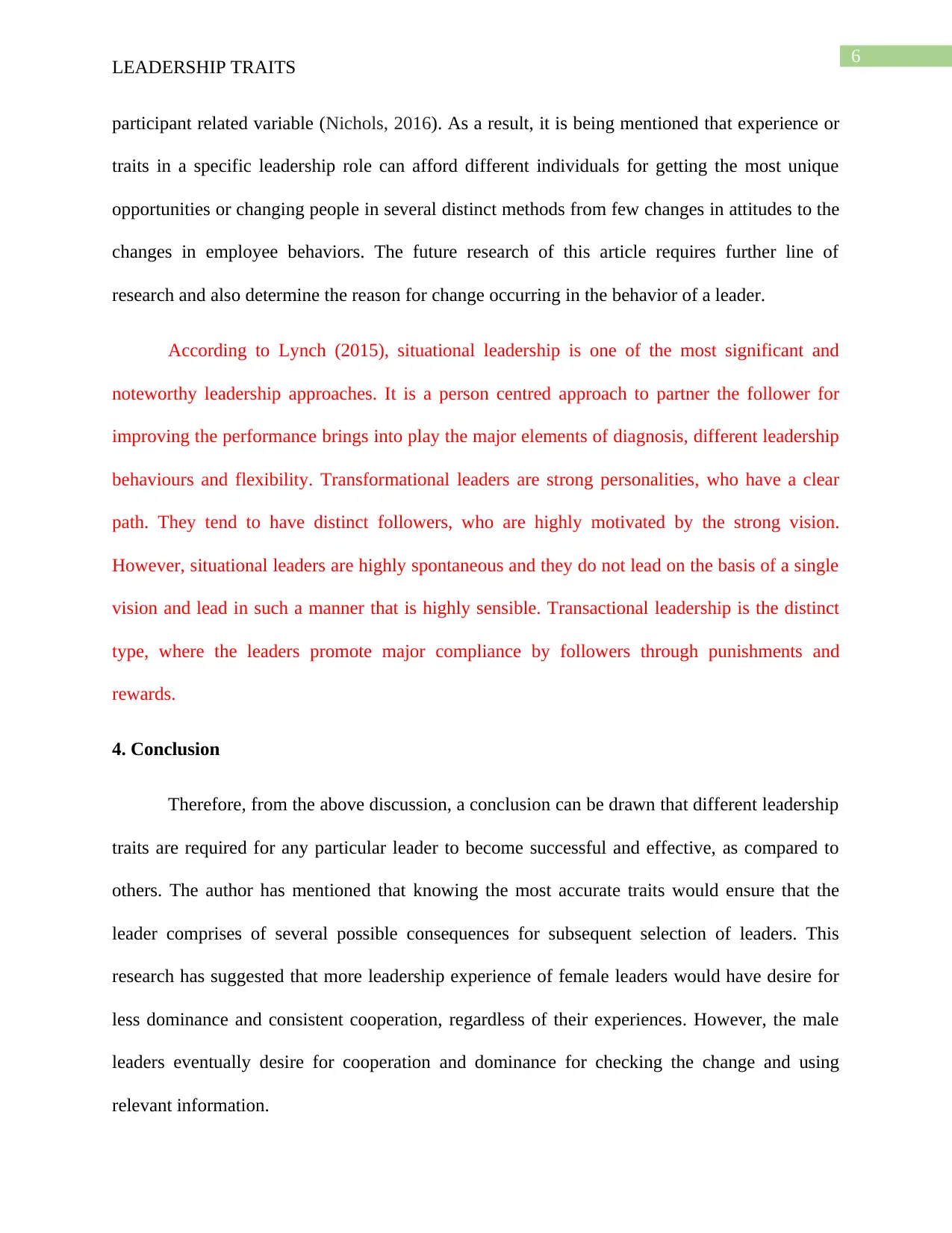
6
LEADERSHIP TRAITS
participant related variable (Nichols, 2016). As a result, it is being mentioned that experience or
traits in a specific leadership role can afford different individuals for getting the most unique
opportunities or changing people in several distinct methods from few changes in attitudes to the
changes in employee behaviors. The future research of this article requires further line of
research and also determine the reason for change occurring in the behavior of a leader.
According to Lynch (2015), situational leadership is one of the most significant and
noteworthy leadership approaches. It is a person centred approach to partner the follower for
improving the performance brings into play the major elements of diagnosis, different leadership
behaviours and flexibility. Transformational leaders are strong personalities, who have a clear
path. They tend to have distinct followers, who are highly motivated by the strong vision.
However, situational leaders are highly spontaneous and they do not lead on the basis of a single
vision and lead in such a manner that is highly sensible. Transactional leadership is the distinct
type, where the leaders promote major compliance by followers through punishments and
rewards.
4. Conclusion
Therefore, from the above discussion, a conclusion can be drawn that different leadership
traits are required for any particular leader to become successful and effective, as compared to
others. The author has mentioned that knowing the most accurate traits would ensure that the
leader comprises of several possible consequences for subsequent selection of leaders. This
research has suggested that more leadership experience of female leaders would have desire for
less dominance and consistent cooperation, regardless of their experiences. However, the male
leaders eventually desire for cooperation and dominance for checking the change and using
relevant information.
LEADERSHIP TRAITS
participant related variable (Nichols, 2016). As a result, it is being mentioned that experience or
traits in a specific leadership role can afford different individuals for getting the most unique
opportunities or changing people in several distinct methods from few changes in attitudes to the
changes in employee behaviors. The future research of this article requires further line of
research and also determine the reason for change occurring in the behavior of a leader.
According to Lynch (2015), situational leadership is one of the most significant and
noteworthy leadership approaches. It is a person centred approach to partner the follower for
improving the performance brings into play the major elements of diagnosis, different leadership
behaviours and flexibility. Transformational leaders are strong personalities, who have a clear
path. They tend to have distinct followers, who are highly motivated by the strong vision.
However, situational leaders are highly spontaneous and they do not lead on the basis of a single
vision and lead in such a manner that is highly sensible. Transactional leadership is the distinct
type, where the leaders promote major compliance by followers through punishments and
rewards.
4. Conclusion
Therefore, from the above discussion, a conclusion can be drawn that different leadership
traits are required for any particular leader to become successful and effective, as compared to
others. The author has mentioned that knowing the most accurate traits would ensure that the
leader comprises of several possible consequences for subsequent selection of leaders. This
research has suggested that more leadership experience of female leaders would have desire for
less dominance and consistent cooperation, regardless of their experiences. However, the male
leaders eventually desire for cooperation and dominance for checking the change and using
relevant information.
Paraphrase This Document
Need a fresh take? Get an instant paraphrase of this document with our AI Paraphraser

7
LEADERSHIP TRAITS
LEADERSHIP TRAITS
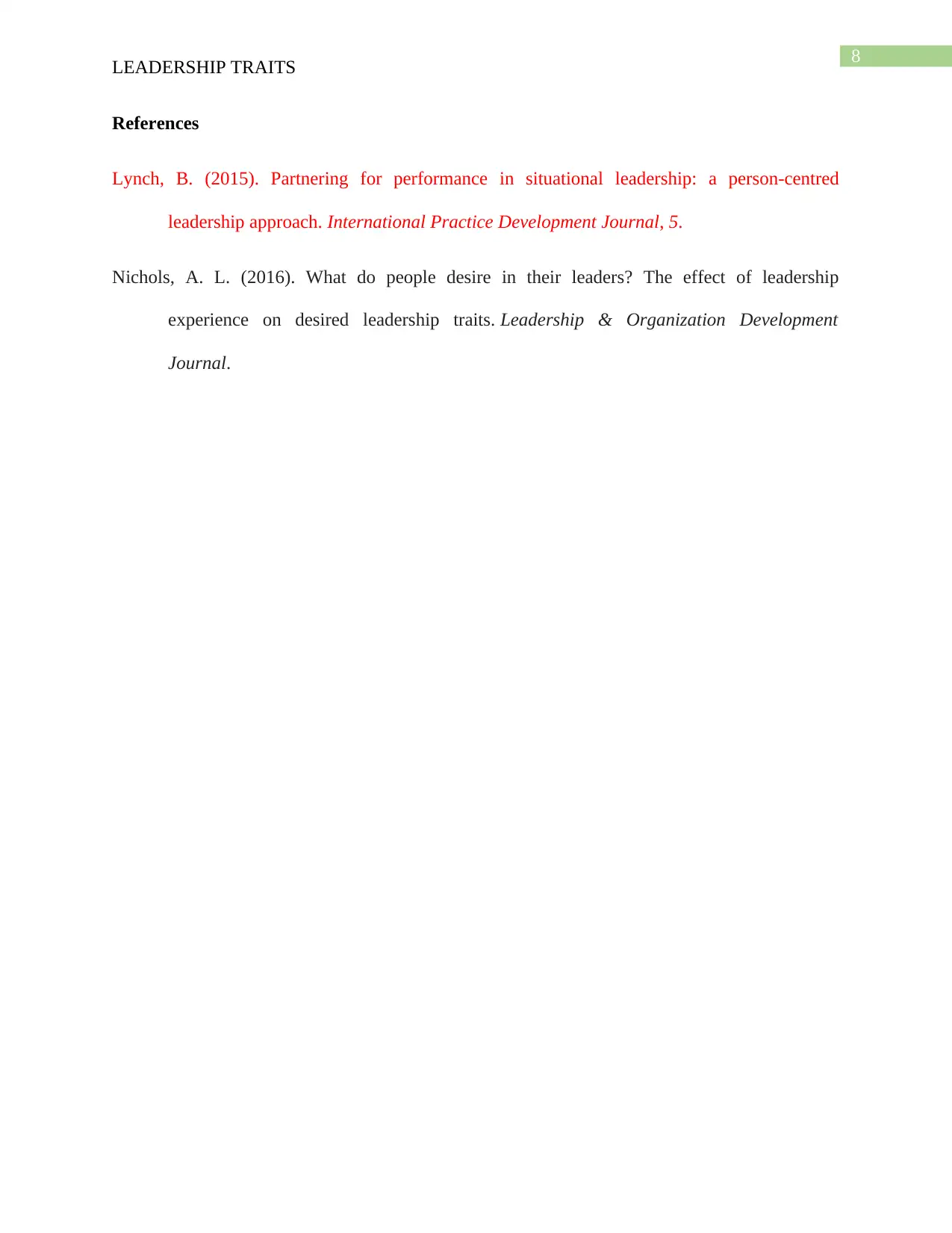
8
LEADERSHIP TRAITS
References
Lynch, B. (2015). Partnering for performance in situational leadership: a person-centred
leadership approach. International Practice Development Journal, 5.
Nichols, A. L. (2016). What do people desire in their leaders? The effect of leadership
experience on desired leadership traits. Leadership & Organization Development
Journal.
LEADERSHIP TRAITS
References
Lynch, B. (2015). Partnering for performance in situational leadership: a person-centred
leadership approach. International Practice Development Journal, 5.
Nichols, A. L. (2016). What do people desire in their leaders? The effect of leadership
experience on desired leadership traits. Leadership & Organization Development
Journal.
⊘ This is a preview!⊘
Do you want full access?
Subscribe today to unlock all pages.

Trusted by 1+ million students worldwide
1 out of 9
Related Documents
Your All-in-One AI-Powered Toolkit for Academic Success.
+13062052269
info@desklib.com
Available 24*7 on WhatsApp / Email
![[object Object]](/_next/static/media/star-bottom.7253800d.svg)
Unlock your academic potential
Copyright © 2020–2025 A2Z Services. All Rights Reserved. Developed and managed by ZUCOL.





